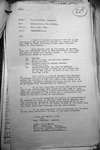Bader was a strange old fish, he wanted to know how to beat the 109 in combat, but also wanted to fly about in groups of 50 in tight formation. That is how not to beat a 109 as flown by the LW.
The new Bf109F had only recently entered service and what he wanted was a quick assessment by combat pilots of its capabilities. R.A.E. farnborough had tested a Bf109E (kindly supplied by the French IIRC) for months before producing a set of figures for it. What they did was test the aircraft,flown by their test pilots,as they would a British aircraft. These figures,whilst correct, are not what front line pilots wanted. The figures Bader was interested in,as evidenced in his letter, were:
1 Ceiling
2 Rate of climb,particularly between 20-30000 feet
3 Maximum speeds at heights between 10-30000 feet
4 Manoeuverability and ease of handling,particularly when pulling out of a steep dive from say 440mph. We know it will pull out from 420mph.
The last one looks a bit dodgy for the test pilot! Bader,and others in the RAF were convinced that Luftwaffe pilots were reluctant to pull hard out of high speed dives ("a bit porky on the joystick" are his actual words) because they believed that they would pull the wings off their aircraft. True or not it is what he believed at the time.
It was Bader's opinion that this information could be obtained by an "experienced pilot in one or two hours flying on the first fine day,with sufficient accuracy for our requirements".
Cheers
Steve

